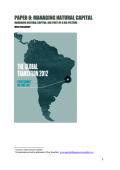
The natural world has a lot to teach us. Above all, it teaches about systems and cycles; that altering one component of a system, however small, can have wider implications within and beyond a given cycle. Human society, the planet and the economy are all systems and are all bound together in intricate relationships. Only when we begin to understand this bigger picture can we tackle the systemic problems facing us. This paper takes a short journey through planetary science to grasp some of the dimensions of those relationships, and poses a series of solutions for affecting the kind of systemic transformation that are urgently needed to ensure the health of the planet and of people. Economic theory (and common sense) explains that when something is valuable, and it is free, its use tends to approach infinity - this explains why trees, biodiversity, freshwater and atmospheric space for carbon are all being used ‘like there is no tomorrow’. It also assumes that when something is exhausted (or too expensive), a substitute is almost certain to be found.
The benefits of hydropower as a source of clean energy with low greenhouse gas emissions are in stark contrast with its negative local social and environmental impacts. This briefing paper discusses this contradiction and the rising importance of affordable clean energy from hydropower in emerging and developing economies. Since hydropower is back on the development agenda this momentum should be used to invest in more environmental and social friendly schemes.
This article explores the regional disputes on the shared river and the degree of cooperation that exists. Despite prevailing negative impacts – i.e., the changes in sedimentation and the river flow regimes – caused by upstream dam construction in Turkey and affecting downstream Georgia, the article finds that the creation of a regional electricity market seems to be opening up a new avenue for cooperation between Turkey and Georgia also on the so far unilaterally utilized river.

The Little Green Data Book provides key environmental data for over 200 economies, based on the World Development Indicators 2015 and its online database. Over 50 indicators are used, organized into categories on: agriculture; forests and biodiversity; oceans; energy and emissions; water and sanitation; environment and health; and national accounting aggregates. Data is presented for the regions of East Asia and Pacific, Europe and Central Asia, Latin America and the Caribbean, Middle East and North Africa, South Asia, and Sub-Saharan Africa.
The 2015 edition uses two new air pollution indicators: mean annual exposure to suspended particulate matter less than 2.5 microns in diameter (PM2.5); and percentage of total population exposed to PM2.5 pollution above the World Health Organization (WHO) Air Quality Guidelines (AQG) value of an annual average of 10 microns per cubic meter. Previous editions used indicators focused on the larger particulates (PM10) and only on urban centers with more 100,000 persons.
Also incorporated this year, are estimates of the economic costs of air pollution, including household air pollution from cooking with solid fuels.

